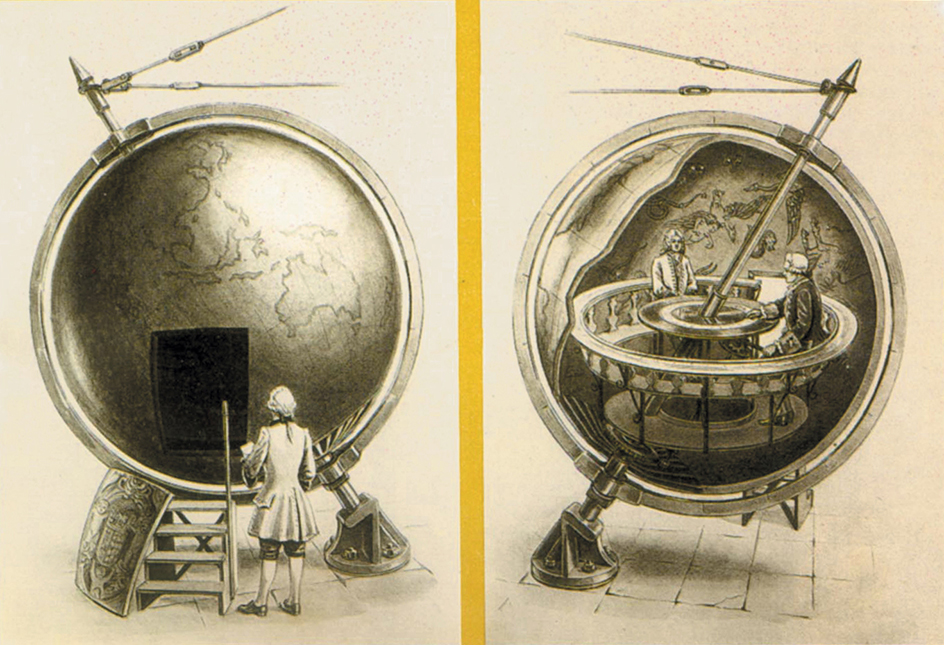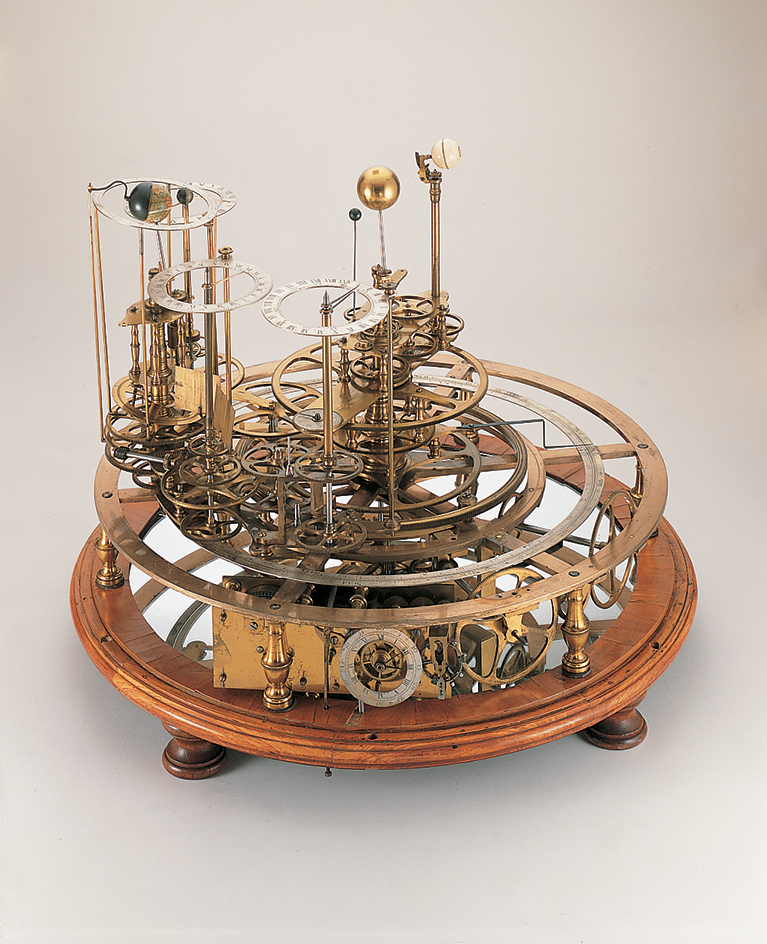Planetarium is an educational device that shows the locations and movements of planets and other objects in the universe. A room or building that houses such a device is also called a planetarium. Each year, millions of people visit such places throughout the world.
Early planetariums were either (1) movable pictures of the starry sky painted on the inside of a sphere or dome or (2) mechanical models of the solar system. A modern planetarium projects images of the sun, moon, planets, stars, and other objects onto the inside of a dome-shaped screen. Until the early 1980’s, planetariums could project the night sky as seen only from Earth. Since then, many planetariums have used computers to simulate (represent) the view from other locations.
Early planetariums
One of the first planetariums with a movable painting of the starry sky was known as the Gottorp Globe. That device was made in the mid-1600’s in what is now Germany. The main part of the planetarium was a hollow copper sphere 10.2 feet (3.1 meters) in diameter. Inside it were a table and a curved bench for 12 people. Painted on the sphere’s inner surface were pictures of the constellations. The stars were copper nailheads coated with gold. Light from a central oil lamp made them shine. A copper globe representing Earth lay on the table.

The hollow sphere could rotate relative to the bench. The sphere’s axis of rotation was an imaginary line that extended from the poles of the copper globe to the sky in the painting. Thus, the sphere’s rotation simulated the apparent motion of the stars as Earth rotates on its axis.
Beginning in the late 1600’s, clockmakers in Europe built small model planetariums that simulated the motion of the planets around the sun. A ball at the center represented the sun. Extending from the center were rods that held smaller spheres representing the planets. By cranking or winding up the model, a person could move its miniature planets around the sun. A system of gears made the planets move at fairly accurate speeds relative to one another. Some models also showed how moons revolved around their planets.
Early in the 1700’s, a model planetarium became known as an orrery—named for the Earl of Orrery, an Irish nobleman who had one made in 1712. The manufacture of small orreries continues to this day. Many science teachers use them because they make the movements of the planets easy to understand.

The invention of electric lights and motors in the late 1800’s made it practical to build large orreries. The first of these was installed in the Deutsches Museum in Munich, Germany, in the early 1920’s. At the center of a circular room was a large lighted globe that represented the sun. Smaller lighted globes represented the planets. The smaller globes were suspended from the ceiling by rods. The rods were attached to motor-driven cars that traveled along “orbital” tracks around the big globe.
Beneath the globe representing Earth was a small, motor-driven platform that an individual could ride. As the orrery ran, a rider could see a simulation of the planets’ revolution around the sun from Earth’s perspective. Similar versions of this kind of orrery were later built at the Hayden Planetarium in New York City and at the University of North Carolina at Chapel Hill.
Modern planetariums
Mechanical projectors.
In 1925, the German firm Carl Zeiss permanently installed the first modern planetarium at the Deutsches Museum in Munich. This device, called the Mark I, was mounted inside a dome 32 feet (10 meters) in diameter. People sat in chairs under the dome and looked up at images of stars, planets, the sun, and the moon.
A hollow metal sphere known as a star ball used 31 lenses to display images of 4,500 stars on the dome. The ball could rotate to simulate Earth’s rotation. Seven additional projectors attached to the ball created images of the sun, the moon, Mercury, Venus, Mars, Jupiter, and Saturn. The seven projectors moved relative to the star ball, thereby simulating the motion of the planets relative to the stars.
The star ball was 20 inches (50 centimeters) in diameter. Light for the images came from a bright electric lamp in the center of the ball. The 31 lenses surrounded the lamp. Mounted behind each lens was a disk called a star plate that acted somewhat like a photographic slide. Light from the lamp passed through holes in the plate. Each hole represented a star; bigger holes simulated brighter stars.
Each projector’s lens focused onto the dome the light that passed through the holes in its star plate. Each plate represented a little more than 3 percent of the night sky. So, working together, the 31 projectors simulated nearly the entire sky.
The Munich planetarium could show how the stars would appear at any time of the night on any date from hundreds of years in the past to hundreds of years in the future. However, the planetarium was limited to views from Munich and other places that have the same northern latitude as that city. That is, the planetarium could show only stars that rose above the horizon at the latitude of Munich.
But improved versions of the Munich planetarium could simulate the sky as seen from any place on Earth and at any time up to 26,000 years into the past or future. The improved planetariums used two large star balls with the planet projectors in between.
The stars look the same from any place in the solar system-though the planets do not. Thus, the planetariums’ simulations represented views of the stars as seen from any place in the solar system. The stars look the same because the solar system is much smaller than the distances to the stars. The average radius of the widest planetary orbit—that of Neptune—is roughly 2.8 billion miles (4.5 billion kilometers). The distance to the nearest star, Proxima Centauri, is about 25 trillion miles (40 trillion kilometers).
The success of the Zeiss projectors led to the establishment of thousands of planetariums in the 1900’s. In the 1930’s, the first Zeiss projectors were installed in the United States—at the Adler Planetarium in Chicago, the Hayden Planetarium in New York City, the Fels Planetarium at the Franklin Institute Science Museum in Philadelphia, and the Griffith Observatory in Los Angeles. During the late 1900’s, the Japanese firms Goto Optical Manufacturing Company and Minolta Company Limited and the U.S. company Spitz Incorporated also became leading makers of planetarium projectors.
The most advanced mechanical projectors can create images as sharp and as precise in color as the actual stars seen from a high mountain. One such device, a Zeiss Mark IX at the Hayden Planetarium in the Rose Center for Earth and Space in New York City, can project images of more than 9,000 stars. The projector has 32 star plates. Light for each star travels from a central lamp through an optical fiber, a hair-thin strand of glass. Because the fiber is so tiny, the image on the dome is pointlike—just like a real star in the sky. Separate projectors steered by computer-controlled motors create images of the sun, the moon, and planets.

Digital projectors.
Even the best mechanical projectors can show the stars as seen from only one region of space—our solar system. The projectors have this limitation because the holes in their star plates cannot change position relative to one another.
However, a digital projector system does not use star plates, and so it does not have this limitation. Instead, a computer creates images on video screens. A lens then projects each image onto the dome. To show the stars as seen from a place other than the solar system, the computer merely changes the images on the screens. A planetarium with computerized projectors is known as a digital planetarium because computers use a code of numbers, or digits, to process information.
In the early 1980’s, the Evans and Sutherland Corporation of the United States installed the first digital planetarium in the Science Museum in Richmond, Virginia. A computer created a single video image of the starry sky. A single large lens then projected this image onto the planetarium dome.
By the mid-1990’s, digital planetariums produced by Evans and Sutherland and other companies brought new realism to images of planets. These advanced planetariums can create close-up views of a rotating planet. They can also simulate the view from a space probe flying over a planet’s surface. And they can even show images of objects that are important in fields other than astronomy. For instance, they can simulate a “flight” through a tremendously magnified image of a living cell.
In addition, digital planetariums can present shows for pure entertainment. One example of such a show is a display of animated, computer-generated art, accompanied by a musical sound track.
A digital planetarium at the Hayden Planetarium uses seven video projectors together to create a single image. The computer is similar to machines used by flight simulators, devices that imitate an airplane in flight.
Even an ordinary desktop or laptop computer that is running certain astronomy software can be thought of as a digital planetarium. Computer programs available on CD-ROM’s can simulate sky conditions for any date and time. Many such programs contain photographs and motion pictures of astronomical objects. Such images are also available on the Internet.
Portable planetariums.
Most school systems and communities cannot afford to buy technologically advanced planetariums. But many of them have purchased inexpensive portable planetariums. One model has an inflatable dome that is designed to hold 35 children. The projector consists of a small light bulb surrounded by a plastic cylinder. Many cylinders are available. For projecting the stars, there is a black cylinder with clear spots for the stars. Other cylinders show galaxies, constellations, and even the inside of a living cell.
